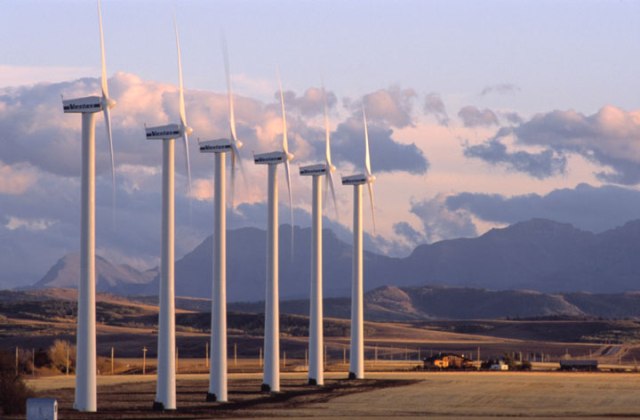
North American clean energy accord to headline Three Amigos summit in Ottawa
by Bruce Cheadle and Mike Blanchfield, The Canadian Press

Powering ahead of both the U.S. and Mexico in renewable generation, Canada could benefit from exporting more electricity south

Canada is already well ahead of both the U.S. and Mexico in terms of clean energy usage. While newer renewables sources such as wind and solar make up an increasing portion of the mix, hydro dominates electricity production in Canada, accounting for about 60 per cent generation. PHOTO: CanWEA
OTTAWA—A North American-wide commitment to cut methane emissions and a pledge to get half the continent’s electricity generation from renewable sources will anchor the Three Amigos summit this week, White House officials said June 27.
When the leaders of Mexico, the United States and Canada convene in Ottawa on Wednesday, the “central focus” will be climate and clean energy, said Brian Deese, senior adviser to President Barack Obama.
“We find ourselves now in a moment where the alignment in terms of policy goals and focus on clean energy between our three countries is stronger than it has been in decades,” Deese told a conference call.
Obama, Prime Minister Justin Trudeau and Mexico’s Enrique Pena Nieto will release what he called a “a comprehensive North American climate, clean energy and environment partnership” that will lay out the specific steps along which the countries will align on a continent-wide basis.
Take an in-depth look at how the agreement will give Canadian cleantech firms and electricity exporters a boost in the U.S. and Mexico
Pena Nieto will sign Mexico on to the Canada-U.S. methane reduction deal announced when Trudeau paid a state visit to Washington in March, according to the White House.
The accord pledges to cut methane emissions 40 to 45 per cent below 2012 levels by 2025 and has been widely applauded by environmental groups as a significant and cost-effective means for combating climate change.
North America accounts for about 20 per cent of global methane emissions, which are a potent greenhouse gas that the Pembina Institute estimates accounts for a fifth of all man-made global warming to date.
The three leaders will also announce a goal to achieve 50 per cent of clean power generation across North American by 2025. That total will include renewable energy, nuclear power, carbon capture and storage and cutting energy waste through increased efficiency, said Deese.
Both the methane and the green energy targets were confirmed late Monday by the Prime Minister’s Office.
Canada has over 80 per cent clean electricity generation by this measure (North America as a whole is at 37 per cent), so Canada could be in a position to export more power than it currently does to the United States.
“There will be discussion about infrastructure, for sure,” said Deese. “The focus there is making sure we have harmonized and integrated infrastructure to encourage clean energies. So transmission, for instance, will be a focus.”
In February, energy ministers from the three NAFTA partners signed a memorandum of understanding in Winnipeg on “climate change and energy collaboration.”
That deal was further advanced earlier this month at a meeting in San Francisco, where Natural Resources Minister Jim Carr, U.S. Energy Secretary Ernest Moniz and Mexico Secretary Pedro Joaquin Coldwell announced the launch of a “North American renewable integration study to better understand the planning and operational impacts of integrating growing renewable energy sources, such as solar, hydro and wind, into our electricity grids,” according to a joint news release at the time.
“The goal of this partnership is really to bring together all of the work that has happened between our respective countries over the last couple of years, first to align our policies, second to integrate our energy systems, everything from trading markets to transmission lines in an effort to try and pave the way for a more rapid acceleration of clean energy deployment across the continent,” said Deese.
Meanwhile, two Canadian provinces, British Columbia and Newfoundland and Labrador, are currently wrestling with massive new hydroelectric projects that critics say will produce power that’s surplus to the Canadian market for years to come.
Securing American hydro sales for B.C.’s controversial Site C dam on the Peace River and Labrador’s Muskrat Falls could be one piece in the federal Liberal government’s energy infrastructure jigsaw puzzle, a potential key to provincial co-operation on other fronts such as pipeline approvals and carbon pricing.
In Canada, 59.3 per cent of all electricity generation comes from hydro—even before Site C and Muskrat Falls generate a single kilowatt-hour.
Wind and other renewables account for about five per cent of Canadian electricity, and emissions-free nuclear power accounts for another 16 per cent.
According to Natural Resources Canada, almost 59 terawatt hours of electricity (59 million megawatts) were exported to the United States in 2014, while about 13 terawatt hours were imported.
B.C. Premier Christy Clark floated the idea of selling B.C. hydro south of the border in a recent interview with The Canadian Press as she made the case for federal environmental permits for Site C.